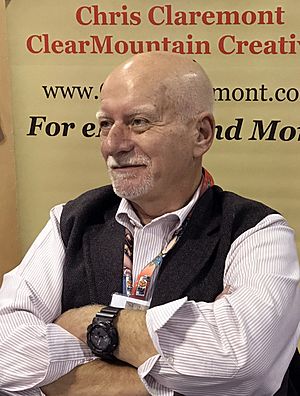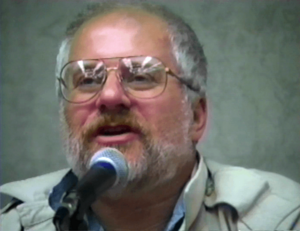Chris Claremont facts for kids
Quick facts for kids Chris Claremont |
|
|---|---|

Claremont at the 2016 New York Comic Con
|
|
| Born | Christopher S. Claremont November 25, 1950 London, England |
|
Notable works
|
Uncanny X-Men New Mutants Captain Britain Excalibur Wolverine Fantastic Four Ms. Marvel Iron Fist X-Treme X-Men |
| Awards | Comics Buyer's Guide Fan Award: 1983, 1984, 1988, 1989, 1990 Eagle Award: 1979 and 1980 Will Eisner Award Hall of Fame (2015) |
| Spouse(s) | Bonnie Wilford (?–?) Beth Fleisher (current) |
| Children | 2 |
Chris Claremont (born November 25, 1950) is a famous English-born American comic book writer. He is best known for his amazing work on Uncanny X-Men for 16 years. From 1975 to 1991, he made the X-Men comic one of Marvel's most popular series. He helped create many strong female characters and added deep stories to superhero comics. During his time, X-Men was the best-selling comic book in the world.
Claremont helped create many popular X-Men characters. These include Rogue, Kitty Pryde/Shadowcat, Phoenix, Mystique, Emma Frost, Jubilee, and Gambit. He also co-created villains like Sabretooth and Mister Sinister.
He wrote many classic X-Men stories. Two of the most famous are "The Dark Phoenix Saga" and "Days of Future Past". He also helped make Wolverine a fan favorite. In 1991, X-Men #1, which Claremont co-wrote, became the best-selling comic book ever. In 2015, Claremont was added to the Will Eisner Award Hall of Fame. This award honors the best creators in comics.
Contents
Early Life and Inspiration
Chris Claremont was born in London, England. His family moved to the United States when he was three years old. He grew up on Long Island. As a child, he loved reading comics like Dan Dare from England. He also enjoyed science fiction books by writers like Robert Heinlein. These stories helped inspire his future work.
A Career in Comics
Starting at Marvel
Chris Claremont started working at Marvel Comics in 1969. He was a college student at the time. His first writing job was for Daredevil in 1973. He then began writing for the "Iron Fist" comic series.
In 1975, Marvel's editor, Len Wein, asked Claremont to write X-Men. The comic was not very popular then. Claremont took the job and started to make the characters feel more real. He explored their feelings, hopes, and dreams. This made readers connect with the characters. His approach helped turn X-Men into a huge success.
Creating Classic X-Men Stories
Claremont introduced many new characters to X-Men. These included Moira MacTaggert and Lilandra Neramani. He also changed Jean Grey into the powerful Phoenix. In 1977, artist John Byrne joined him. Together, they created some of the most famous X-Men stories.
"The Dark Phoenix Saga" and "Days of Future Past" are two of their most important works. These stories are seen as landmarks in comic history. They showed how deep and exciting superhero comics could be. Claremont also worked with artist Frank Miller on a Wolverine comic series in 1982.
Claremont also helped create the New Mutants team in 1982. This team later got its own comic series. The movie X-Men 2 was partly based on his 1982 graphic novel, God Loves, Man Kills.
Expanding the X-Men Universe
Claremont created many other important characters for the X-Men. These include Rogue, Kitty Pryde, Mystique, and Jubilee. He also created male characters like Sabretooth and Gambit.
He launched many X-Men spin-off comics. These included The New Mutants (1982), Excalibur (1987), and Wolverine (1988). In 1991, Marvel launched a second X-Men comic simply called X-Men. Claremont co-wrote the first issues with artist Jim Lee. X-Men #1 sold over 8.1 million copies. This made it the best-selling comic book of all time.
Later Work in Comics
After 1991, Claremont started working on other projects. He wrote for different comic publishers. He also created his own comic series. In 1995, he started Sovereign Seven for DC Comics.
In 1998, Claremont returned to Marvel. He wrote Fantastic Four for a few years. He also returned to writing Uncanny X-Men and X-Treme X-Men. In 2004, he worked with John Byrne again on the JLA comic for DC Comics.
Claremont continued to write for Marvel. In 2014, he wrote a new Nightcrawler series. In 2019, he worked with artist Bill Sienkiewicz on New Mutants: War Children.
Claremont's Writing Style
Chris Claremont is known for his detailed and complex stories. He made comic book stories more mature and thoughtful. His editor, Louise Simonson, said he took the X-Men characters very seriously. They felt like real people to him.
Claremont's writing often focused on themes of prejudice. He said that as an immigrant, he felt like an outsider. This helped him connect with the X-Men, who are also outsiders. His stories showed how mutants were like minorities in the real world. This message resonated with many readers.
Other Creative Works
Novels and Acting
In 1987, Claremont began writing science fiction novels. He wrote a trilogy about a female pilot named Nicole Shea. He also co-wrote the Chronicles of the Shadow War trilogy with George Lucas. These books continued the story from the movie Willow.
Claremont also made small appearances in movies. He was in the 2006 film X-Men: The Last Stand. He also appeared in the 2014 film X-Men: Days of Future Past.
Charity Work and Archives

In 2010, Chris Claremont took part in events for World AIDS Day. He helped raise money for a group that teaches young people about HIV/AIDS prevention.
In 2011, Claremont donated his old writings and notes to Columbia University. This collection includes his notebooks, letters, and early story ideas. It helps people study how comic books are created. In 2012, Columbia University held a special event called Comic New York. It celebrated Claremont's gift and the history of comics in New York City.
Awards and Recognition
Chris Claremont has received many awards for his work:
- 1980 Inkpot Award
- 1992 Comics Buyer's Guide Fan Award for Favorite Graphic Novel or Album for Star Trek: Debt of Honor
- 1979 Eagle Award for Best Comicbook Writer (US)
- 1979 Eagle Award for Favourite Single Story – X-Men #111 – "Mindgames"
- 1979 Eagle Award for Favourite Comicbook – X-Men
- 1979 Eagle Award for Favourite Group or Team – X-Men
- 1980 Eagle Award for Favourite Comicbook Writer
- 1980 Eagle Award for Favourite Continued Comic Story – X-Men #125–128
- 1980 Eagle Award for Favourite Comicbook – X-Men
- 1980 Eagle Award for Favourite Team – X-Men
- 1984 Eagle Award for Favourite Group or Team (US) – X-Men
- 1986 Eagle Award for Favourite Group or Team (US) – X-Men
- Charles Flint Kellogg Award in Arts and Letters from Bard College
See also
 In Spanish: Chris Claremont para niños
In Spanish: Chris Claremont para niños


